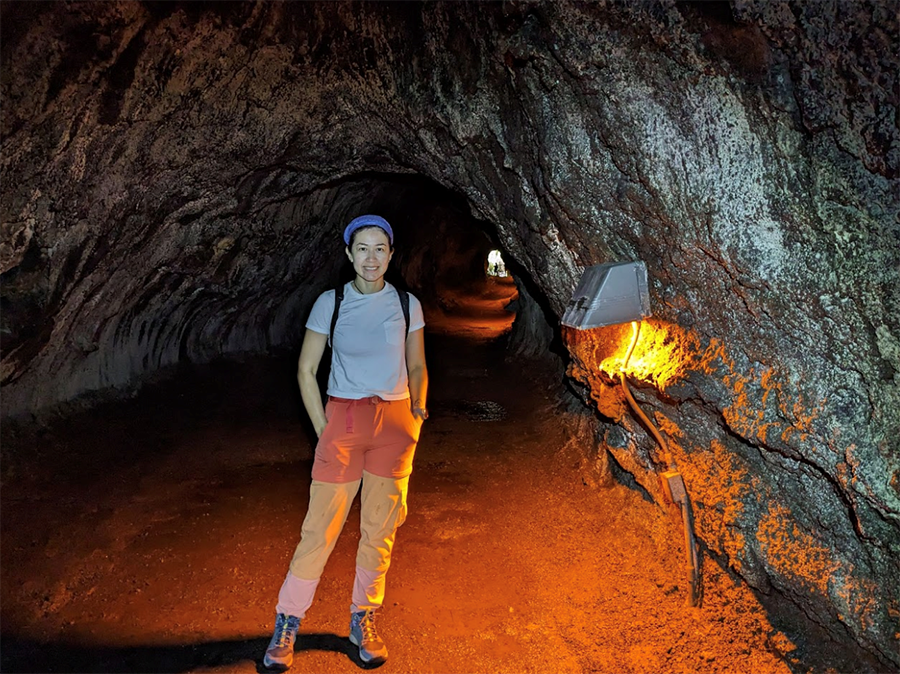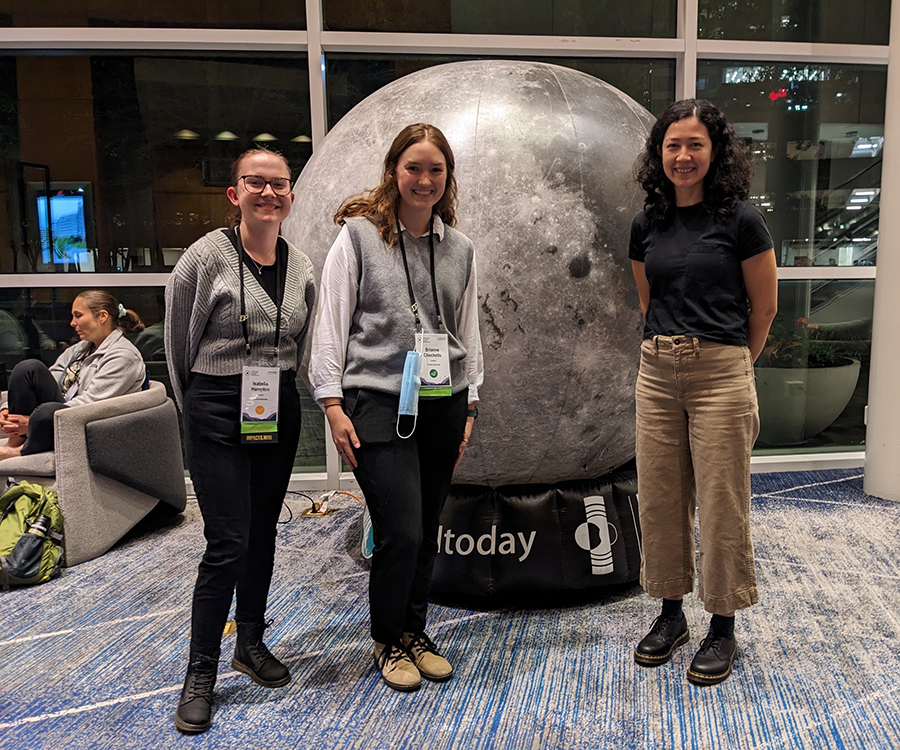Purdue scientists discover volcanic material on the Moon where it has never been detected before
02-07-2024

Lava once flowed on the Moon like the arteries of a giant celestial living beast. The lava flow that has been frozen in time for millions of years on and just below the surface like veins of an organism can give scientists an insight into how and when this massive beast operated and what caused the activity to come to its eventual cold and quiet death.
Researchers at Purdue University’s Department of Earth, Atmospheric, and Planetary Sciences use Moon data to find the locations of volcanic deposits globally on the Moon. They have discovered never before detected deposits of volcanic activity that were undetectable by mere visual images of the moon. The team, led by Kris Izquierdo, postdoctoral researcher at Purdue University, recently published their findings in JGR Planets.
“In our study, we use measurements of the acceleration of gravity to infer the location of the volcanic rocks on the Moon,” explains Izquierdo. “The acceleration of gravity is related to the mass or density of the material. Locations with higher gravity correspond to locations where the material is denser or heavier. We know that volcanic rocks of the Moon are denser than the non-volcanic rocks, so we assume that regions with higher-than average acceleration are produced by these rocks. In this way, we are able to find the locations of volcanic deposits globally on the Moon. We discover new deposits that hid from surface images because they are buried by other material. Our results show that a higher volume of volcanic rocks is present on the lunar crust than previously proposed, meaning that a higher volume of lavas erupted during the early lunar history.”
The team of researchers consists of lead author, Izquierdo, Mike Sori, assistant professor with Purdue University’s Department of Earth, Atmospheric, and Planetary Sciences (EAPS), Brandon Johnson, associate professor of EAPS, Jason Soderblom, research scientist at MIT, and two EAPS undergraduate students Brianne Checketts and Isabella Hampton.

Izquierdo led the gravity analysis of the buried volcanic material and the effort to link the results to interferences on the past volcanic activity of the Moon. Sori, Johnson and Soderblom developed the concept of the project and obtained the project funding by justifying its feasibility, promise, and relevance to the NASA Lunar Data Analysis Program (LDAP). The two undergraduate students made a significant contribution to this work by mapping dark halo craters on the Moon, which are the geologic evidence of buried volcanism.
“The Moon is currently a cold, rocky planetary body where nothing much happens. However, in the past, volcanism was active in the Moon and lavas flowed in similar way as they do in Hawaii today,” says Izquierdo. “We can understand several aspects of this past volcanic activity by analyzing clues left in the now solidified, frozen-in-time, volcanic rocks on the lunar surface. Knowledge of this past volcanic activity are useful for understanding the evolution of all rocky planets that haven’t cooled down completely yet including Mercury, Venus, Earth, and Mars.”
The team searched for mare basalt deposits globally on the Moon. Mare is the most abundant volcanic material on the lunar surface. The biggest mare deposits are formed by lava flowing into large impact basins on the near side of the Moon, the side that can be seen from Earth. The name “mare” comes from the Latin world “sea” because initially these deposits were thought to be actual seas on the Moon. The team also used data collected from lunar missions to establish their findings. They used gravity data from the Gravity Recovery and Interior Laboratory (GRAIL) mission that orbited the Moon for three months in 2013. They also used albedo images of the lunar surface taken by the Lunar Reconnaissance Orbiter mission and iron content images from the Clementine mission.
“We find dark halo craters up to 15 km in diameter so, in theory, they could be observed with a commercial telescope from Earth,” she says. “However, in the visible light spectrum, the signature dark halo surrounding these craters is not easy to identify. The material of the halo is darker than the surrounding material but the contrast in color might not be as sharp as to be detected by a telescope. In this study we find that the best way to clearly identify these craters is by the higher iron content of the halo, compared to the surrounding material. People interested in mapping these craters do not need a telescope, instead they can use the software LROC Quickmap to visualize the lunar surface, including the iron content and the location of crater rims.”
The Moon is currently a “dead” planetary body without active volcanism. Lavas are not currently being erupted on the lunar surface because the Moon lacks the internal heat needed for these lavas to be buoyant and rise through the crust. The youngest volcanic material was erupted around 2 billion years old, as detected by China’s Chang’e-5 mission. The team used the combined gravity and iron content data to establish the distribution of the now cold and solidified volcanic rocks that exist on the lunar surface to infer the extent of the past volcanic activity of the Moon.
“Understanding the spatial distribution, total content, and ages of volcanic deposits on the Moon is essential to understand the thermal evolution of this body and the thermal evolution of rocky planets in general,” says Izquierdo. “We can learn what is the origin of such a difference between the volcanically rich nearside of the Moon and the seemingly depleted farside. We can learn about the cooling rate of the Moon which went from a completely melted rocky body with high volcanic activity to a cold, inactive one. Finally, we can learn about the processes that promoted or inhibited the rise of melted rock through the crust of the Moon in the past: the thickness of the crust, the porosity of the rock, the thermal gradient between mantle and crust, etc.”
The team hopes that discoveries like this one lead to further study or even missions to help understand the rich history of our moon.
“The study of lunar volcanism is not the direct focus of the upcoming crewed Artemis program to land humans on the Moon,” she says. “These upcoming missions are focused on studying the volatile content of the Moon because of the importance of mapping water and ice to establishing a long-term presence of humans on the Moon. However, discovering new volcanic regions, like the ones we propose in the lunar farside, could motivate the development of future missions focused on understanding early volcanism.”
About the Department of Earth, Atmospheric, and Planetary Sciences at Purdue University
The Department of Earth, Atmospheric, and Planetary Sciences (EAPS) combines four of Purdue’s most interdisciplinary programs: Geology & Geophysics, Environmental Sciences, Atmospheric Sciences, and Planetary Sciences. EAPS conducts world-class research, educates undergraduate and graduate students, and provides our college, university, state and country with the information necessary to understand the world and universe around us. Our research is globally recognized, our students are highly valued by graduate schools, employers, and our alumni continue to make significant contributions in academia, industry, and federal and state government.
About Purdue University
Purdue University is a public research institution with excellence at scale. Ranked among top 10 public universities and with two colleges in the top 4 in the United States, Purdue discovers and disseminates knowledge with a quality and at a scale second to none. More than 105,000 students study at Purdue across modalities and locations, with 50,000 in person on the West Lafayette campus. Committed to affordability and accessibility, Purdue’s main campus has frozen tuition 12 years in a row. See how Purdue never stops in the persistent pursuit of the next giant leap, including its first comprehensive urban campus in Indianapolis, the new Mitchell E. Daniels, Jr. School of Business, and Purdue Computes, at Purdue's Strategic Initiatives.
Contributor: Kris Izquierdo, postdoctoral researcher at Purdue University
Writer: Cheryl Pierce, Communications Specialist